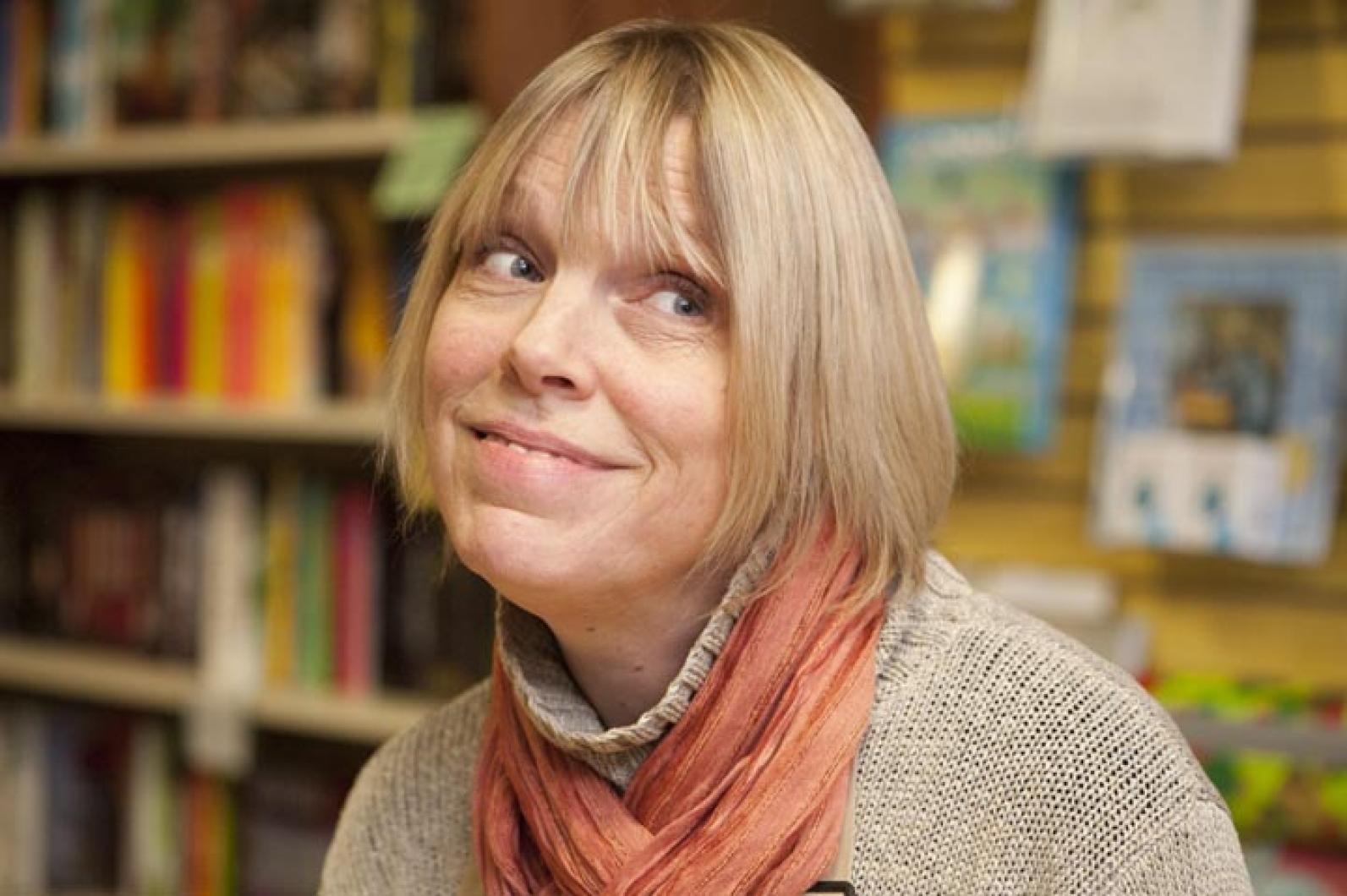On Tuesday, Susan Savory, the recently installed children’s bookseller at the Bunch of Grapes Bookstore in Vineyard Haven, warmly surveyed her second floor domain. A mother and child quietly sat on the store’s beanbag chairs engrossed in the richly-illustrated, understated moral universe of the children’s book.
“That’s my favorite part of the job,” she said. “I think that the things we read when we were kids have a great deal to do with the kind of adults we become.” If that is the case, it seems (much to Ms. Savory’s chagrin) that we are rearing a country of vampires.
“I’m not a fan of this whole paranormal romance thing,” she said. “But some of it’s better than others.”
Ms. Savory comes to the Vineyard after a life on the mainland as a Parsons New School-educated illustrator, whose collage work is still featured in a Chatham gallery, and a children’s bookseller, who at one point ran her own bookstore (Shoofly Pie) in New Hampshire.
The constellation of independent booksellers in New England is a close-knit, almost familial clan, and when Ms. Savory heard through the grapevine about the opening at Bunch of Grapes, an independent bookstore that she regards as “the best in New England,” it wasn’t long before she shipped off the continent.
“I had no intention of moving here or anywhere for that matter,” she said. “I was happy where I was. But when I walked through the door downstairs, I thought, this is it. This is the bookstore.”
While small bookstores everywhere face annexation by the big box store chains, Ms. Savory remains fiercely loyal to the independent ideal.
“At places like Barnes and Nobles they hire cashiers, they don’t hire booksellers,” she said. “We’re here because we really love it and we want to share it.”
Ms. Savory is especially passionate about picture books. An October New York Times story pronouncing the death of the medium prompted an anxious conversation in the world of children’s literature. It is a premise that Ms. Savory rejects.
“I don’t believe in the death of the picture book and I’m going to fight tooth and nail for them,” she said. “I think that people are buying fewer picture books but they’re buying better picture books. You see sometimes, not so much here but especially on the mainland, parents pushing their kids to read beyond their level.
“But I love picture books and I think kids need them. There are picture books with no words and there are picture books with as many words as some beginning readers. It’s a great step.”
And you can’t shop for them on Amazon, she says.
“You can’t buy a picture book without holding it in your lap, turning the pages and smelling it.”
Besides their pedagogic value Ms. Savory thinks that the books provide an equally valuable service in providing an early encounter with art for children. The wholly original, sometimes startling art work of children’s books, she says, is invaluable in a distracted digital age.
“I feel bad for this generation because they will never have album cover art and liner notes,” she said, her sunny disposition belying the battle scars of a one-time rock-and-roller. Ms. Savory recently finished reading the National Book Award-winning Just Kids by the aging rocker Patti Smith, and reflects warmly on seeing Ms. Smith herself in concert at the legendary CBGB club in New York city in 1973.
Unsurprisingly, Ms. Savory says that on Christmas morning in her household books are the main attraction. So what is on her holiday book list this year?
For children she recommends the beautifully illustrated The Quiet Book by Deborah Underwood, and Oh No!: Or How My Science Project Destroyed the World by Mac Barnett, illustrated by Dan Santat.
The latter, as its title indicates, involves a little girl’s robot that runs amok and takes over the world. “It’s really great,” she said.
For middle grade readers Ms. Savory recommends a series called the Penderwicks by Jeanne Birdsall, The Mysterious Benedict Society by Trenton Lee Stewart and The Lost Hero by Rick Riordan, the latest in a series on Greek mythology by the author.
“It’s a brilliant way to learn your myths without a boring textbook,” she said. “They’re wonderful, they’re engaging and boys especially love them.”
For older readers Ms. Savory sees a literary landscape populated by outsized talents such as Sharon Dogar, whose book, Annexed, explores the perils of Nazism from the point of view of Anne Frank’s attic companion, Peter van Pels.
“I have a couple of young adult authors that I really love,” she said. “John Green is one of them. He writes smart contemporary fiction with a great sense of humor. And I love Suzanne Collins and her series The Hunger Games. It’s beautifully written, scary, and no vampires.”
In addition to books tailor-made for the adolescent set, Ms. Savory says that any young adult reading list should be complemented with a sampling from the grown-up shelves.
“There are a lot of things in adult fiction that young adults should be reading and I’m trying to fill my young adult section with some of those books,” she said. “Books like The Once and Future King by T.H. White, To Kill a Mockingbird and The Member of the Wedding by Carson McCullers. Books that make the young adult section a much more well-rounded place to read, as opposed to just vampires.”
Sometimes, though, books listed as young adult literature can best their supposedly more refined counterparts in the adult section. One such book for Ms. Savory was the 2010 National Book Award Winner for young people’s literature, Mockingbird by Kathryn Erskine.
“I loved it. Loved it,” she said. “More than most fiction for adults. It’s the story of a little girl with Asperger’s syndrome who loses her brother and has a complicated relationship with her dad. It’s moody and it’s beautifully written
. . . and there’s not a vampire in sight.”




Comments (4)
Comments
Comment policy »